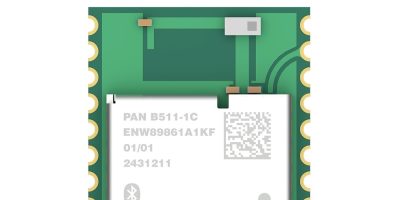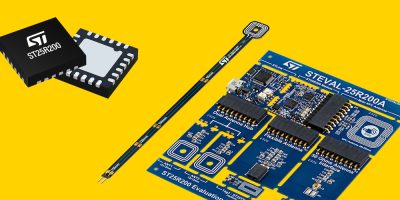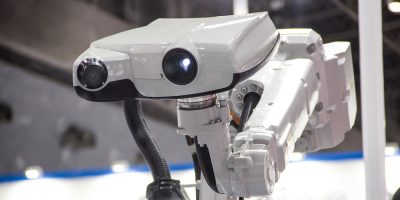The newly launched small and cost-effective PAN B511-1C Bluetooth module from Panasonic Industry features great performance and great memory while minimising current consumption based on the Nordic nRF54L15 single chip controller.
A dedicated number of GPIOs is positioned at the edge of the module, with the rest of the GPIOs located at the bottom pad. In total, the module provides access to all 32 GPIOs of the chip. Despite its hybrid packaging of castellated holes and LGA, the module remains at the small size of a 2-cent coin. This way, it combines the advantages of both worlds without compromising on size and enables one of the best pin-to-size ratios for Bluetooth modules currently on the market. Its edge pins facilitate easier hand-soldering and support the use of inexpensive 2-layer PCB designs and optical inspection methods, eliminating the need for costly X-ray machines.
The module also features an embedded microcontroller and ARM Cortex- M33 with a high amount of flash memory of 1.5 MB and a RAM size of 256 kB.
An output power of 8dbm makes the module ideally suited for the European market. The main target applications are lighting, home appliances, industrial sensors, medical devices, healthcare wearables and energy management devices and solar farms. Furthermore, the PAN B511-1C is ideally suited for Matter applications, as it comes equipped with additional flash memory and is fully compatible with the PAN MAX Service that facilitates the production and launch of Matter production. The module will be available in three distinct spec variants to cater to diverse project needs.
The PAN B511-1C Bluetooth module will be certified for CE RED, FCC, ISED and MIC. Samples are already available now and the start of mass production is scheduled for June 2025.
Weartech-Design Sources / Software
Upgraded sensor board from ST accelerates plug-and-play evaluation
ST’s latest-generation sensor evaluation board, the STEVAL-MKI109D. is now upgraded with an STM32H5 microcontroller, USB-C connector, and extra digital interfaces including I3C for flexible communication , the new board lets users quickly evaluate sensors and handle demanding projects.
Engineers unveiled the STEVAL-MKI109D during a live tech lab, showing how to simply plug in a sensor module, connect a PC, and start analysing data in ST MEMS Studio. Using this all-in-one graphical environment, developers can visualise the sensor output, quickly fine-tune settings, configure features, and exercise the AI capabilities of ST sensors with a machine-learning core (MLC) and intelligent sensor processing unit (ISPU) inside. The tool provides advanced functions including power monitoring and supply voltage management that help optimise energy consumption and debugging.
ST’s MEMS portfolio contains inertial sensors, pressure sensors, biosensors, and digital and analog microphones offering many choices of speed, accuracy, full-scale range, and package style in industrial, consumer, and automotive grades. Extremely compact and robust, they are suited to diverse applications including consumer products, smartphones, wearables, smart-home devices, industrial sensing, safety equipment, healthcare, environmental monitoring, and many more. Automotive-grade devices target applications including navigation support, advanced driver assistance, and automated driving.
An evaluation module is available for each sensor type, mounted on a convenient DIL24 card with headers, ready to connect to the STEVAL-MKI109D board. Additional plug-and-play accessories are available, including biosensor electrodes and remote-sensing extension cables to quickly evaluate sensors when building proof-of-concept models and developing prototypes.
The STM32H5 MCU at the heart of the new board has the latest high-performing and efficient Arm® Cortex®-M33 core with extensive peripherals that enable faster, more convenient development. Customers’ sensor projects can target any of the over 1400 microcontrollers and microprocessors in the STM32 family. The MLC, finite-state machine (FSM), and ISPU embedded in select MEMS devices help optimise application performance and power consumption for superior functionality, responsiveness, and battery runtime.
New NFC reader IC and modular kit from ST jumpstarts contactless designs
ST is making it easier to explore creative applications for contactless near-field communication (NFC) technology with a novel development kit featuring the new ST25R200 reader/writer IC. ST’s latest-generation ST25R200 NFC transceiver combines an advanced design for strong and clear wireless connections with low power consumption and controls for signal quality and power management.
The STEVAL-25R200SA kit for reader evaluation contains an ultra-compact ST25R200 board, ready for power-up, and multiple antennas that let users try single, dual, and flexible designs. The evaluation kit is complete with a 50-Ohm antenna interface and programmable tags.
This modular kit helps quickly build proof-of-concept models to demonstrate convenient short-range wireless communications for device pairing, configuring settings, or product authentication to ensure brand protection. The main board and antennas are NFC-certified and suitable for diverse industrial, consumer, and health technologies, such as medical devices, power tools, household appliances, game consoles, and personal care devices.
The ST25R200 NFC reader features ST’s noise suppression receiver (NSR), which ensures high immunity to interference even when close to a noise source such as an LCD panel contained in the same device. The receive circuitry also features an advanced analog front end (AFE), standard NFC-A/B (ISO 14443A/B) and NFC-V (ISO 15693) data framing.
Enhanced low-power card detection (LPCD), also built-in, eases wake-up to ensure a smooth and seamless user experience. The 1.2W transmitter has dynamic power output (DPO) control to regulate the field strength and overshoot/undershoot protection to ensure consistent signalling throughout data exchanges.
This reader operates over a wide power supply and peripheral I/O voltage range from 2.7V to 5.5V and from -40°C to 85°C. In addition, there are multiple operating modes to assist power management, cutting the device current to as little as 1µA to extend the runtime of battery-powered applications. In reset mode the IC draws just 0.1µA.
Arrow Edge AI engineering services launches to boost support for advanced device development
Arrow Electronics is strengthening support for customers seeking to accelerate their embedded applications with artificial intelligence and machine learning by launching Arrow Edge AI engineering services. The resources include engineering consultancy, technical training, design services, ready-to-use software, and a curated selection of vendor-specific and independent tools.
“Analysts say AI will be one of the biggest technologies of the coming decade. In fact, AI algorithms are already embedded in many consumer and industrial applications and are an essential ingredient for reaching the latest performance and power efficiency targets,” said Morten Block, marketing director EMEA, Arrow Electronics. “Developing AI applications to run on edge computing platforms is no trivial task, so Arrow Edge AI engineering services is here to handle the challenges. With solutions for every stage of the development lifecycle, we help our customers keep their projects on track, from initial analysis and determining the right approach, to algorithm development, model training, optimisation, and deployment.”
Edge AI represents numerous opportunities for product developers to create innovative products, such as wearables, IoT gateways, smart sensors, autonomous machines, and others, to be deployed throughout factories, cities, homes, smart buildings, agriculture, utility networks, and retail. In addition to increasing performance and efficiency, edge AI can also enhance security and relieve dependence on continuous network connectivity.
The Arrow Edge AI engineering services portfolio covers the spectrum of edge AI applications, including object detection, facial recognition, industrial inspection, voice control, sound analysis, and touch sensing.
In addition to consulting and design assistance, Arrow Edge AI engineering services will offer extensive training, including AI theory, algorithm development, modelling, software tools, and applications such as predictive maintenance. Accessible through an online hub, the service will also provide learning resources, articles and videos to help users achieve their goals.
About Smart Cities
This news story is brought to you by smartcitieselectronics.com, the specialist site dedicated to delivering information about what’s new in the Smart City Electronics industry, with daily news updates, new products and industry news. To stay up-to-date, register to receive our weekly newsletters and keep yourself informed on the latest technology news and new products from around the globe. Simply click this link to register here: Smart Cities Registration







